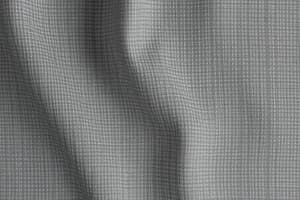Podcast
Questions and Answers
What type of solutions are ketchup and mustard stains classified as?
What type of solutions are ketchup and mustard stains classified as?
- Liquid solutions
- Semi-solid, semi-liquid solutions (correct)
- Solid solutions
- Organic solutions
What role do surfactants play in stain removal?
What role do surfactants play in stain removal?
- They absorb moisture from the fabric.
- They help to remove, separate and suspend stain components. (correct)
- They enhance the color of the fabric.
- They oxidize the stains to break them down.
How do bleaches assist in the stain removal process?
How do bleaches assist in the stain removal process?
- They make stains more water-soluble by breaking down molecules. (correct)
- They increase the viscosity of the stain.
- They bind with the fabric to strengthen its fibers.
- They enhance the fragrance of the fabric.
What type of stains do enzymes specifically target?
What type of stains do enzymes specifically target?
Which of the following is a method of applying pre-treatment products?
Which of the following is a method of applying pre-treatment products?
What is the recommended use of baking soda in stain removal?
What is the recommended use of baking soda in stain removal?
What is the effect of the natural acidity in lemon and lime on stains?
What is the effect of the natural acidity in lemon and lime on stains?
How should baking soda be applied for effective stain removal?
How should baking soda be applied for effective stain removal?
What is the primary function of lemon or lime juice when applied to stains?
What is the primary function of lemon or lime juice when applied to stains?
For which type of stain is corn starch particularly effective?
For which type of stain is corn starch particularly effective?
How long should you allow hydrogen peroxide to sit on a stain before washing the garment?
How long should you allow hydrogen peroxide to sit on a stain before washing the garment?
What kind of stains does salt work best on?
What kind of stains does salt work best on?
How should dish soap be used to effectively remove stains?
How should dish soap be used to effectively remove stains?
What caution should be taken when using lemon or lime juice on clothing?
What caution should be taken when using lemon or lime juice on clothing?
What is the recommended action if salt does not significantly lighten a red wine stain after 10 minutes?
What is the recommended action if salt does not significantly lighten a red wine stain after 10 minutes?
What is the main purpose of using corn starch on a stain?
What is the main purpose of using corn starch on a stain?
What was the primary reason for the invention of synthetic laundry detergents during WWI?
What was the primary reason for the invention of synthetic laundry detergents during WWI?
Which of the following substances were used as the basic raw materials for laundry soaps in the early 20th century?
Which of the following substances were used as the basic raw materials for laundry soaps in the early 20th century?
What is the primary function of surfactants in detergents?
What is the primary function of surfactants in detergents?
What significant change occurred in the laundry detergent market by 1953?
What significant change occurred in the laundry detergent market by 1953?
Which type of detergent is characterized by the presence of caustic soda?
Which type of detergent is characterized by the presence of caustic soda?
What are built detergents known for?
What are built detergents known for?
What type of synthetic detergent has a negatively charged head?
What type of synthetic detergent has a negatively charged head?
How are current laundry detergents classified?
How are current laundry detergents classified?
Why are inhibitors added to certain detergent formulations?
Why are inhibitors added to certain detergent formulations?
What is one drawback of traditional laundry soaps?
What is one drawback of traditional laundry soaps?
What distinguishes synthetic detergents from traditional soaps?
What distinguishes synthetic detergents from traditional soaps?
What distinguishes non-detergent soap from other cleaning agents?
What distinguishes non-detergent soap from other cleaning agents?
Which of the following is NOT a common application for synthetic detergents?
Which of the following is NOT a common application for synthetic detergents?
What types of products fall under the category of laundry aids?
What types of products fall under the category of laundry aids?
Which of the following is an example of a synthetic detergent?
Which of the following is an example of a synthetic detergent?
What characteristic allows certain detergents to produce foam in ice-cold water?
What characteristic allows certain detergents to produce foam in ice-cold water?
What is the primary result of the saponification process involving alkalis and fats?
What is the primary result of the saponification process involving alkalis and fats?
Which type of soap is specifically used for personal hygiene?
Which type of soap is specifically used for personal hygiene?
What does Total Fat Matter (TFM) indicate about a soap?
What does Total Fat Matter (TFM) indicate about a soap?
Which type of soap is designed primarily for aesthetic appeal?
Which type of soap is designed primarily for aesthetic appeal?
Why have laundry soaps historically had lower cleaning power?
Why have laundry soaps historically had lower cleaning power?
What common ingredients are found in modern beauty soaps?
What common ingredients are found in modern beauty soaps?
What type of water should be used for laundering synthetic fabrics?
What type of water should be used for laundering synthetic fabrics?
What was one reason for the spread of soap usage in the US?
What was one reason for the spread of soap usage in the US?
How should silky fabrics be rinsed after washing?
How should silky fabrics be rinsed after washing?
Which of the following statements is not true about beauty soaps?
Which of the following statements is not true about beauty soaps?
Why should synthetic fabrics not be squeezed tightly after washing?
Why should synthetic fabrics not be squeezed tightly after washing?
What is the recommended method for washing knitted woolen clothes?
What is the recommended method for washing knitted woolen clothes?
How should woolen clothes be dried after washing?
How should woolen clothes be dried after washing?
What is the best way to store woolen clothes?
What is the best way to store woolen clothes?
What should be avoided when laundering silks?
What should be avoided when laundering silks?
What should be done to maintain the shape of knitted woolen clothes after washing?
What should be done to maintain the shape of knitted woolen clothes after washing?
Flashcards
Solvent
Solvent
A substance that dissolves other substances, particularly in a liquid form.
Like Dissolves Like
Like Dissolves Like
The principle that states substances with similar proprieties tend to dissolve in each other.
Surfactant
Surfactant
A substance that helps remove, separate, and suspend stain components from fabric.
Bleach
Bleach
Signup and view all the flashcards
Enzyme
Enzyme
Signup and view all the flashcards
Pre-treatment
Pre-treatment
Signup and view all the flashcards
Baking Soda
Baking Soda
Signup and view all the flashcards
Lemon/Lime
Lemon/Lime
Signup and view all the flashcards
Lemon/Lime Juice
Lemon/Lime Juice
Signup and view all the flashcards
Non-Detergent Soap
Non-Detergent Soap
Signup and view all the flashcards
Hydrogen Peroxide
Hydrogen Peroxide
Signup and view all the flashcards
Detergent
Detergent
Signup and view all the flashcards
Cornstarch
Cornstarch
Signup and view all the flashcards
Lime Soap (Curd)
Lime Soap (Curd)
Signup and view all the flashcards
Salt
Salt
Signup and view all the flashcards
Dish Soap
Dish Soap
Signup and view all the flashcards
Builders
Builders
Signup and view all the flashcards
Laundry Aids
Laundry Aids
Signup and view all the flashcards
Pre-treating Stains
Pre-treating Stains
Signup and view all the flashcards
Rubbing in Stain Remover
Rubbing in Stain Remover
Signup and view all the flashcards
WWII Era
WWII Era
Signup and view all the flashcards
Washing After Pre-treatment
Washing After Pre-treatment
Signup and view all the flashcards
Water Hardness Tolerance
Water Hardness Tolerance
Signup and view all the flashcards
Cleaning & Health
Cleaning & Health
Signup and view all the flashcards
What are non-detergent soaps?
What are non-detergent soaps?
Signup and view all the flashcards
What are toilet soaps?
What are toilet soaps?
Signup and view all the flashcards
What are laundry soaps?
What are laundry soaps?
Signup and view all the flashcards
What are beauty soaps?
What are beauty soaps?
Signup and view all the flashcards
What are novelty soaps?
What are novelty soaps?
Signup and view all the flashcards
What is saponification?
What is saponification?
Signup and view all the flashcards
What is Total Fat Matter (TFM)?
What is Total Fat Matter (TFM)?
Signup and view all the flashcards
How did soap become popular?
How did soap become popular?
Signup and view all the flashcards
Detergent Builders
Detergent Builders
Signup and view all the flashcards
Time Window
Time Window
Signup and view all the flashcards
Chemical Concentration
Chemical Concentration
Signup and view all the flashcards
Water Temperature
Water Temperature
Signup and view all the flashcards
Materials of Construction
Materials of Construction
Signup and view all the flashcards
Operator Safety
Operator Safety
Signup and view all the flashcards
Risk to Food Safety
Risk to Food Safety
Signup and view all the flashcards
Why should synthetics be washed in cold water?
Why should synthetics be washed in cold water?
Signup and view all the flashcards
Why is starch used for silk?
Why is starch used for silk?
Signup and view all the flashcards
Why are woolens more delicate than other fabrics?
Why are woolens more delicate than other fabrics?
Signup and view all the flashcards
Why must knitted woolen garments be dried flat?
Why must knitted woolen garments be dried flat?
Signup and view all the flashcards
What type of soap should be used for woollens?
What type of soap should be used for woollens?
Signup and view all the flashcards
What washing technique should be used for woollen clothes?
What washing technique should be used for woollen clothes?
Signup and view all the flashcards
Why are paper outlines used for washing knitted woolens?
Why are paper outlines used for washing knitted woolens?
Signup and view all the flashcards
How should woolens be stored?
How should woolens be stored?
Signup and view all the flashcards
Study Notes
Care and Renovation of Textiles
- Pre-treating is more effective than repeated washing, tackling issues before washing.
- Pre-treating prevents and removes stains, odors and dinginess; creating a smooth surface for ink adhesion.
- Textiles have fuzz, lint and irregular surfaces which affect ink adhesion.
- Targeted pre-treating, using appropriate stain-fighting products and proper cleaning, helps overcome most stains.
- Some stains (e.g., ring around collar, pit stains) build up over time.
- Prevent stain creep by pretreating targeted areas with stain-fighting products.
- Dinginess is a buildup of fibers, minerals or soap.
- Soaking dingy items in stain-fighting products before washing removes buildup.
- Odors (body odor, smoke, cooking odor, musty odor) are removed by prewashing or presoaking with odor-removing products.
Stain Removal Methods
-
Dissolving in solvents: Solvents dissolve solids or liquids in stains. Examples include organic solvents removing butter, bacon grease, and other organic stains.
-
Lifting by surfactants: Surfactants "make water wetter", penetrate fabric fibers, surround stain molecules and lift them away through rinsing.
-
Oxidizing with bleach: Bleaches (chlorines and peroxides) decolorize or break down molecules in some stains, making them more water-soluble and easier to remove, such as grass, wine, and fruit juice.
-
Digesting with enzymes: Enzymes break down protein stains like eggs, dairy, and meat, and starch stains like pasta, effectively removing them from fabric.
-
Pre-treatment products include Baking soda, Lemon/lime, Hydrogen peroxide, Corn starch, Salt, Dish soap, Laundry detergent
Types of Stains
- Protein stains: Baby food, milk, blood, cream, cheese sauce, pudding, egg, gelatin, white glue, ice cream.
- Tannins stains: Alcoholic beverages, beer, berries, coffee, tea, juice, cologne, washable ink, soft drinks.
- Oil-based stains: Automotive oil, hair oil, lotion, butter, grease, cooking oil, creams, cuff greasing.
- Dye stains: Cherry, blue berry, color bleeding in wash (dye transfer), grass, Indian IWL, paint, felt tip pen ink, mustard.
- Combination stains: Example: Ballpoint ink, candle wax, carbon paper, crayon, eye makeup, pencils, floor wax, resin, shoe polish, tar, calamine lotion, tomato sauce, cocoa or chocolate, face makeup (powder, rouge, foundation), gravy, hair spray.
- Stains needing special treatment: Chewing gum, deodorants, nail polish, lead pencil varnish, pesticide, rust, smoke, water spots.
Stain Removal Techniques
- Brushing: Removing dried stains. Use a brush (like a toothbrush) on a flat surface and move the brush from the outside to the middle of the stain.
- Flushing: Used for loosening staining materials and removing residues. Gently apply the recommended stain-removal agent on the stained area and allow it to absorb.
- Scraping: Removing semisolid and caked-on stains. Be gentle and avoid damaging the fabric. Use a dull knife, spoon or spatula.
- Tamping: Effective on tightly woven fabrics. This technique involves repeatedly tapping the stained area with a soft-bristled brush, or toothbrush, on a flat surface.
- Freezing: For stains like candle wax and gum. Place the fabric in a plastic bag and put it in the freezer to harden the stain for lifting or scraping.
- Sponging: Laying stained fabric flat and using a pad or sponge to apply stain remover, move the sponge and/or pad to different sections.
Laundry Detergents
- Heavy-duty: Liquid or powdered detergents suitable to remove tough dirt.
- Light-duty: Often liquid detergents for delicate fabrics, designed to remove lighter dirt.
Bleaches
- Hydrogen peroxide: Used as a natural bleaching agent, removing specific stains (e.g., grass, wine, fruit juice).
- Powdered all-fabric bleaches: Examples like sodium perborate and sodium percarbonate, widely suitable for all types of fabrics.
- Liquid chlorine bleach: A strong bleaching agent to remove most stubborn stains, but is not recommended for all types of fabrics.
Home Remedies for Stain removal
- Various home remedies are mentioned for specific stains like red wine, coffee, oil/grease, ink, blood etc with methods including using baking soda, white vinegar, etc.
Chemical Solvents
- Various chemical solvents are suggested including water, vinegar, hydrogen peroxide, etc; for use in removing different types of stains
Safety Precautions
- Proper storage of stain removers and chemicals.
- Using stain removers in a well-ventilated room.
- Avoid contact with skin and eyes.
- Never mix potentially dangerous chemicals or stain remover products:
Laundering of Textiles
- Detailed steps are provided for washing, rinsing, bleaching, drying
Studying That Suits You
Use AI to generate personalized quizzes and flashcards to suit your learning preferences.




